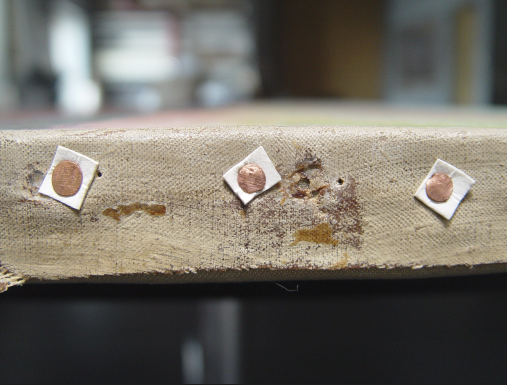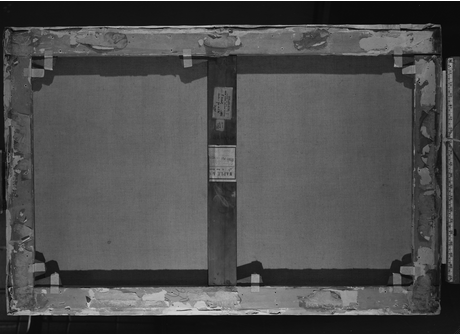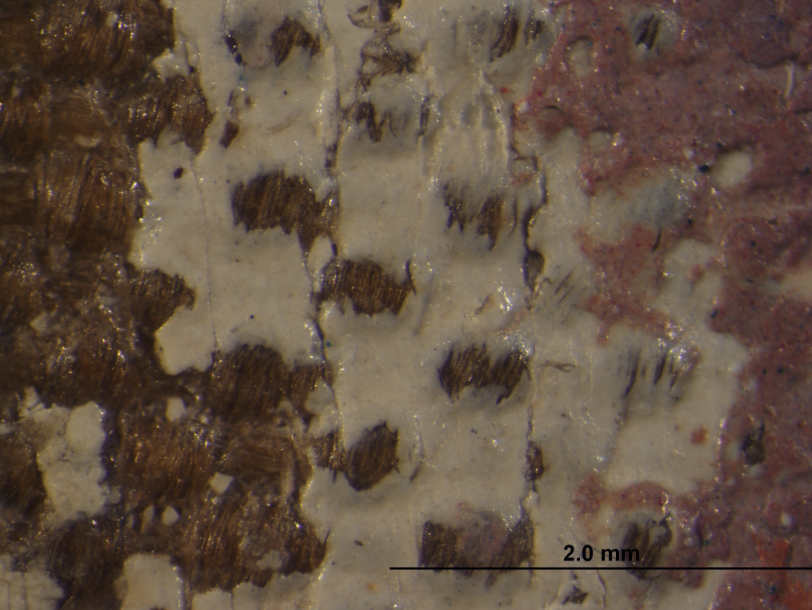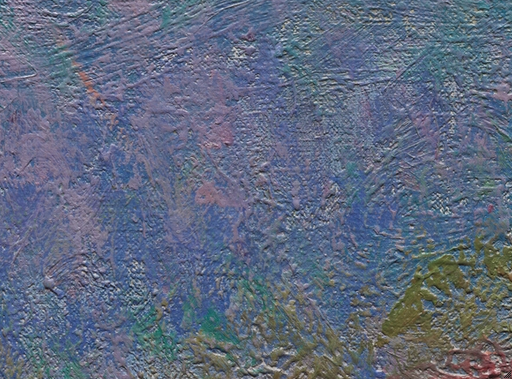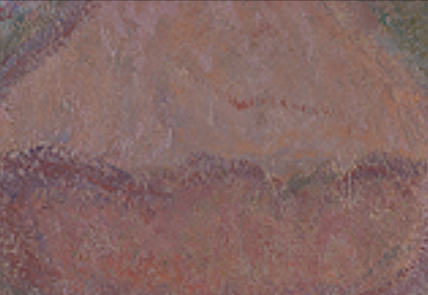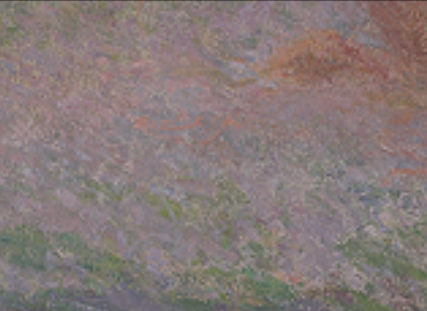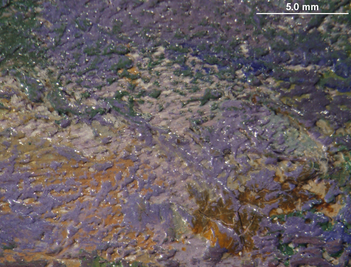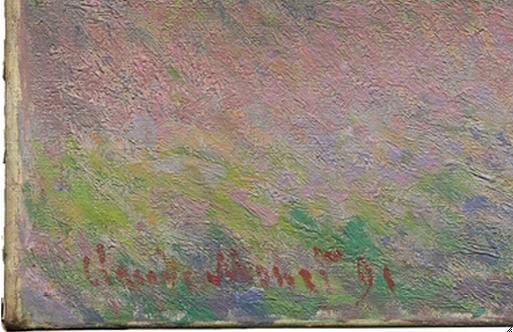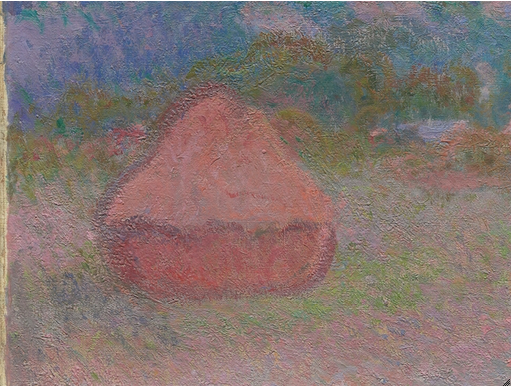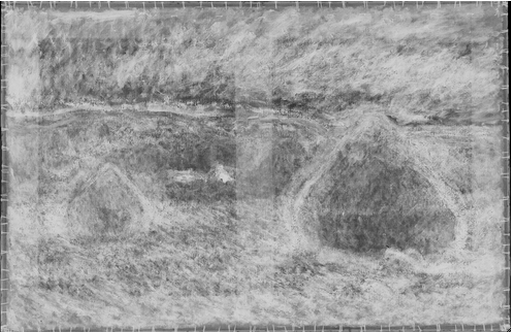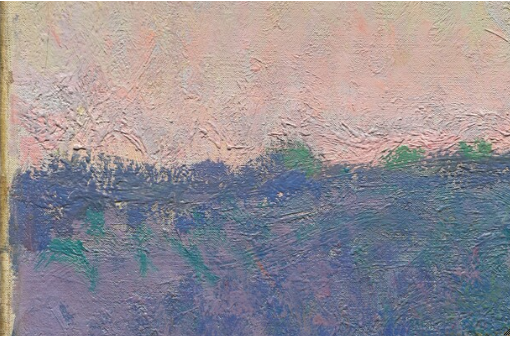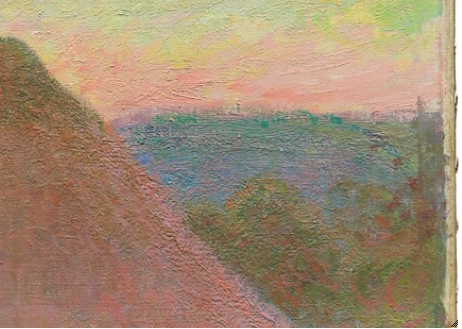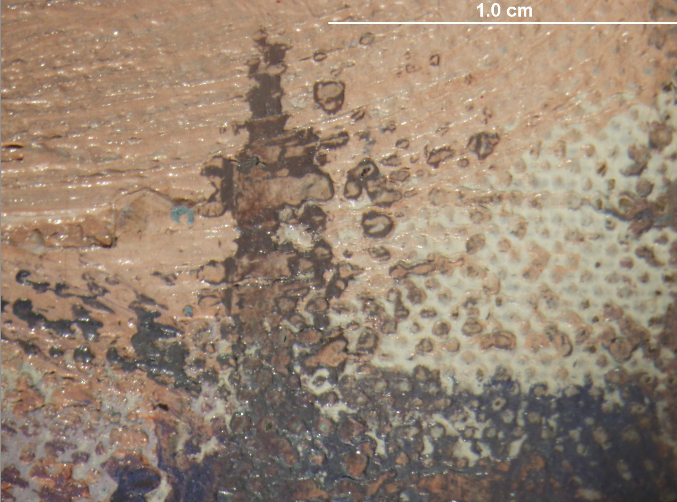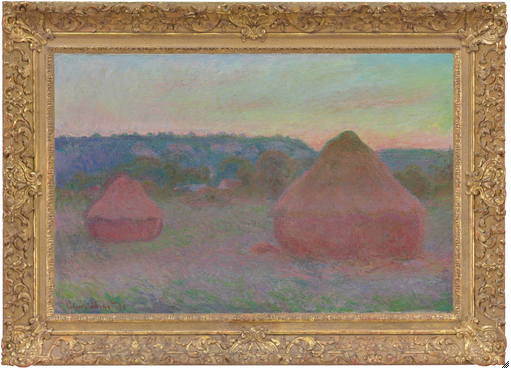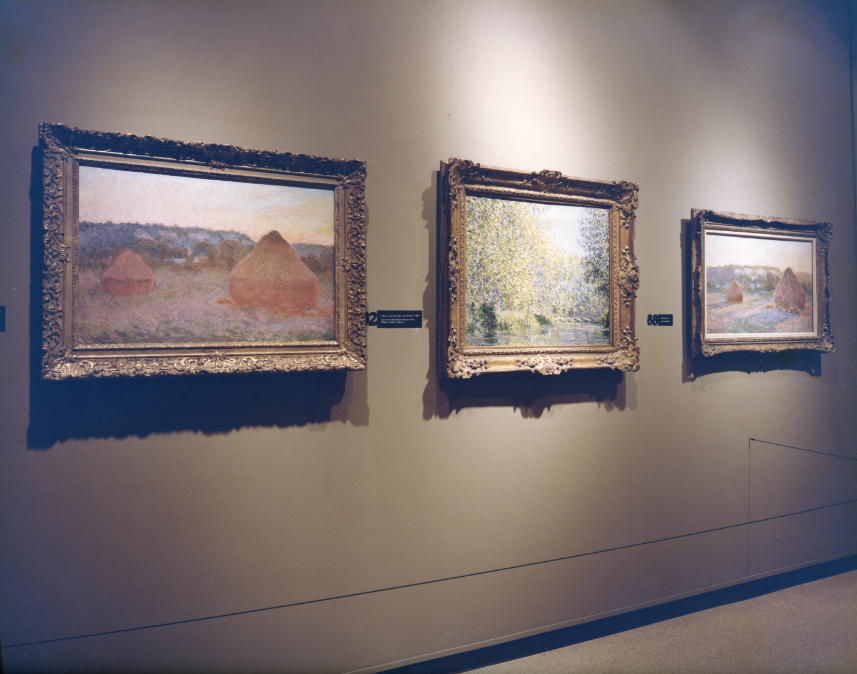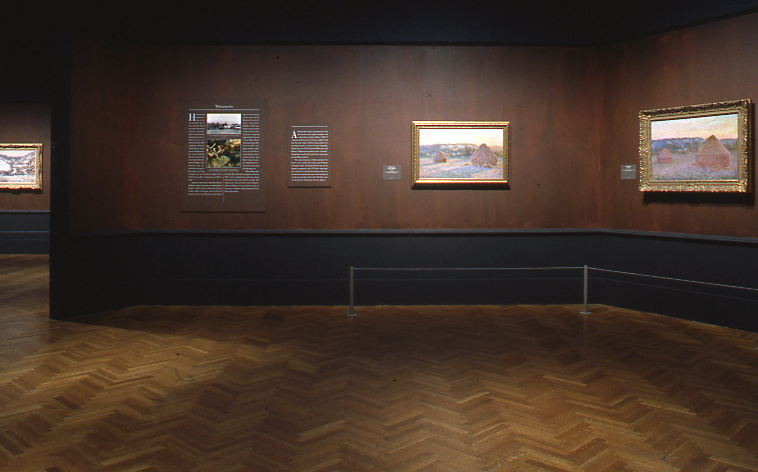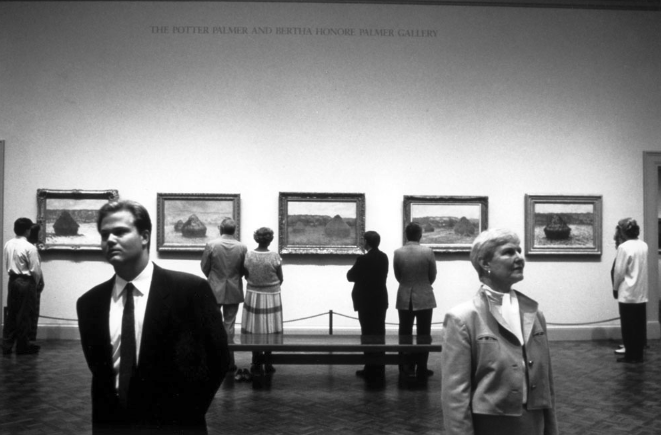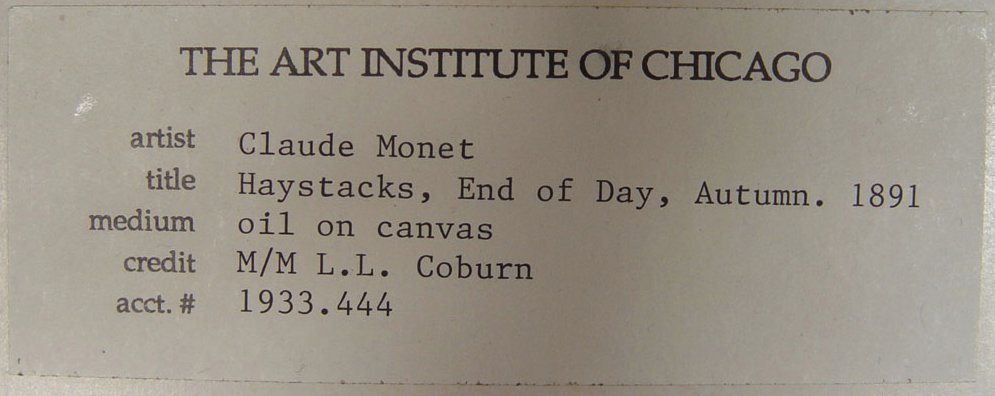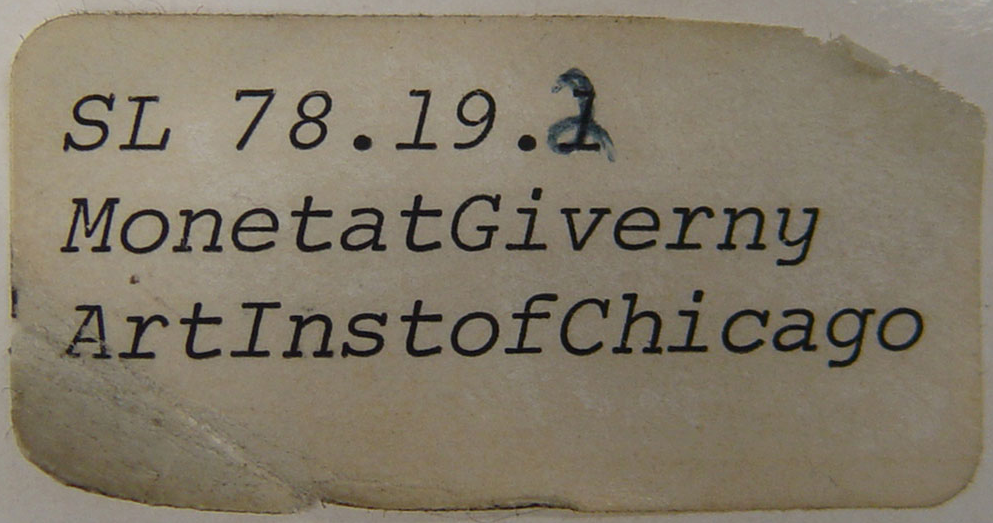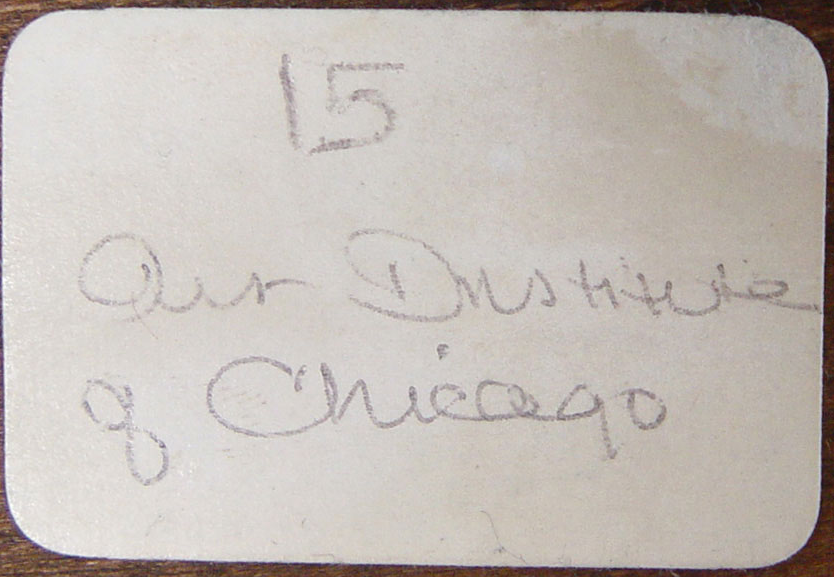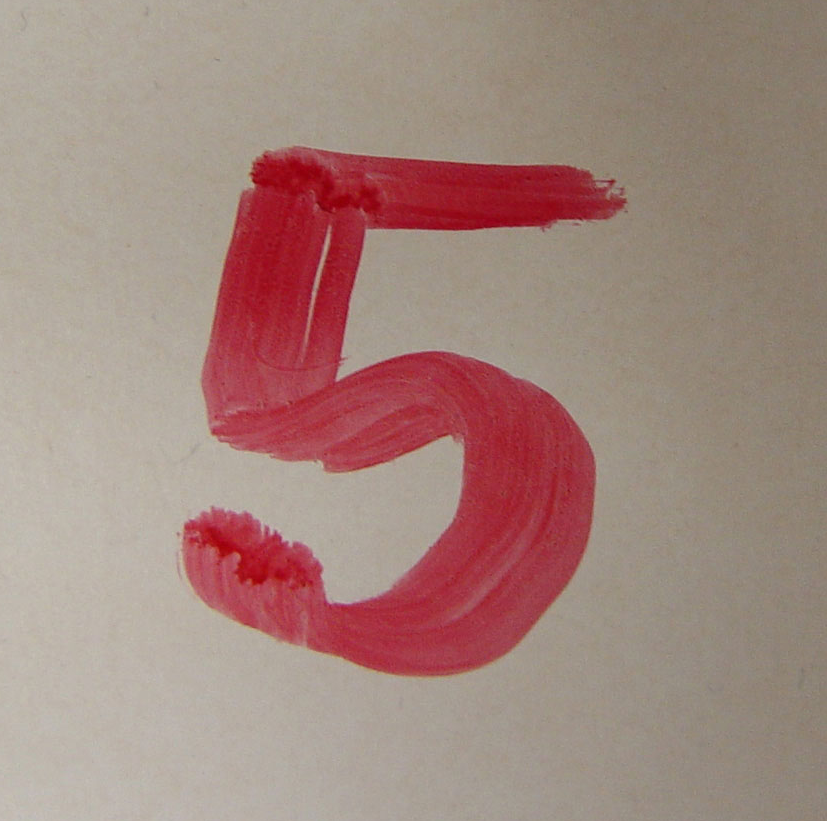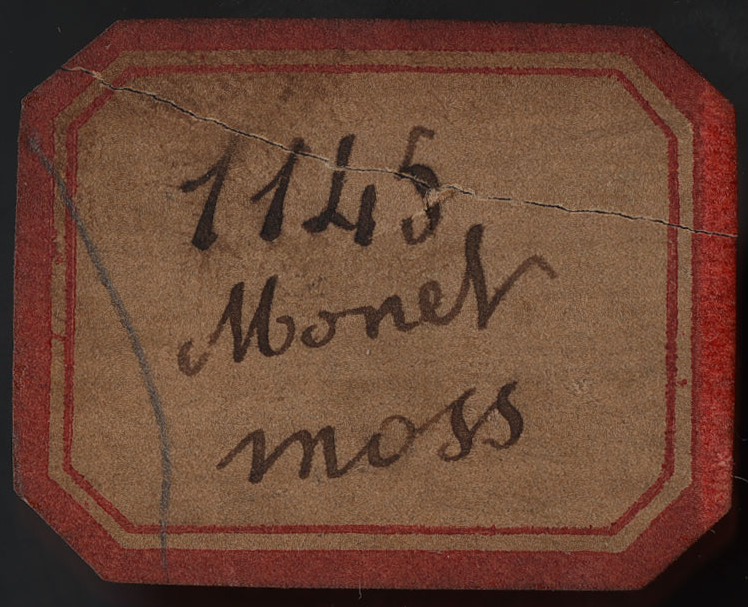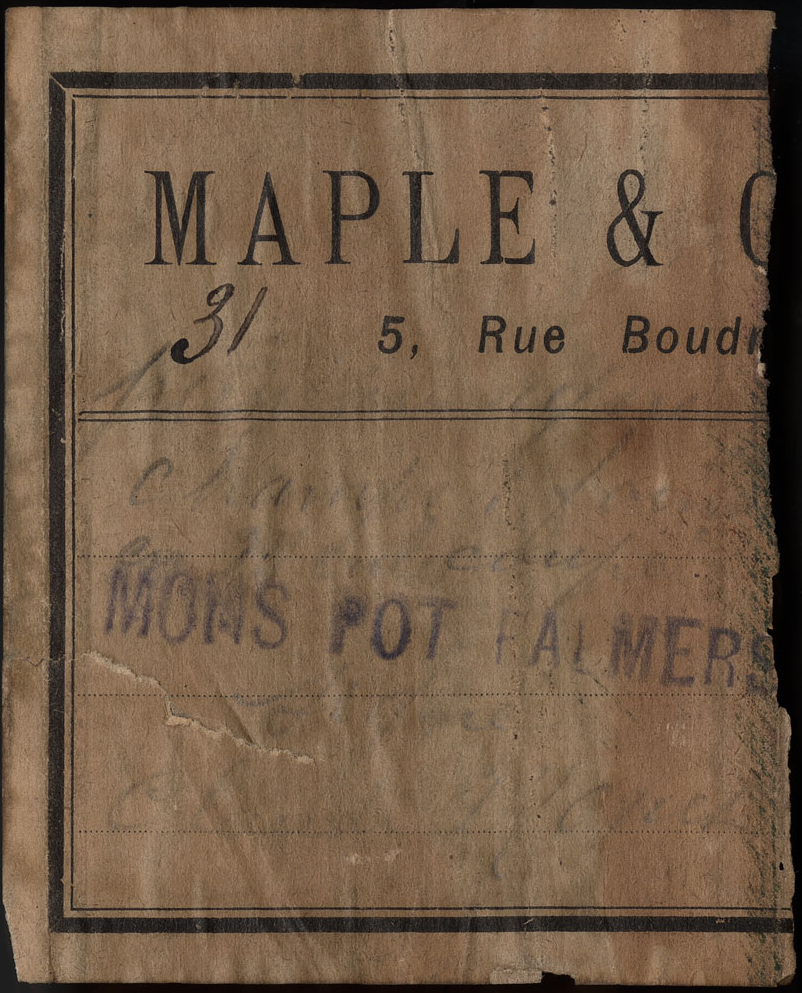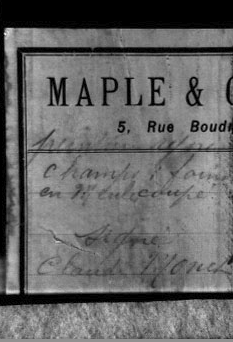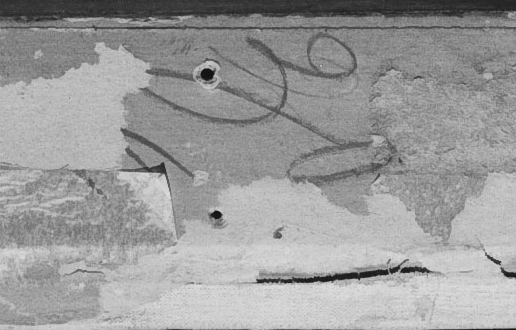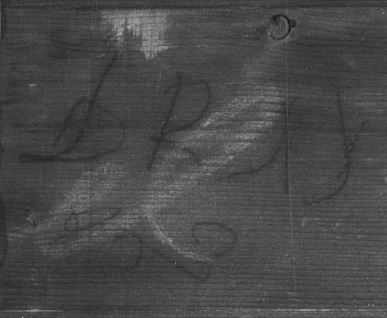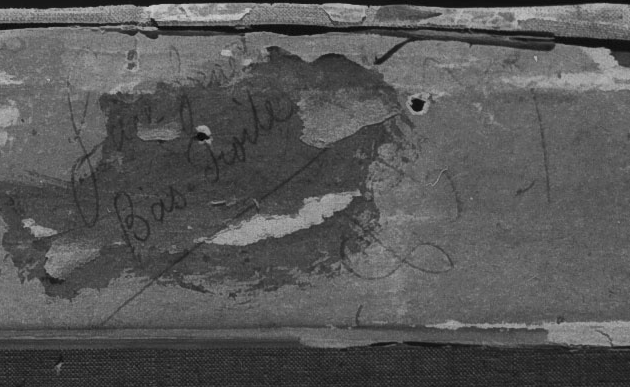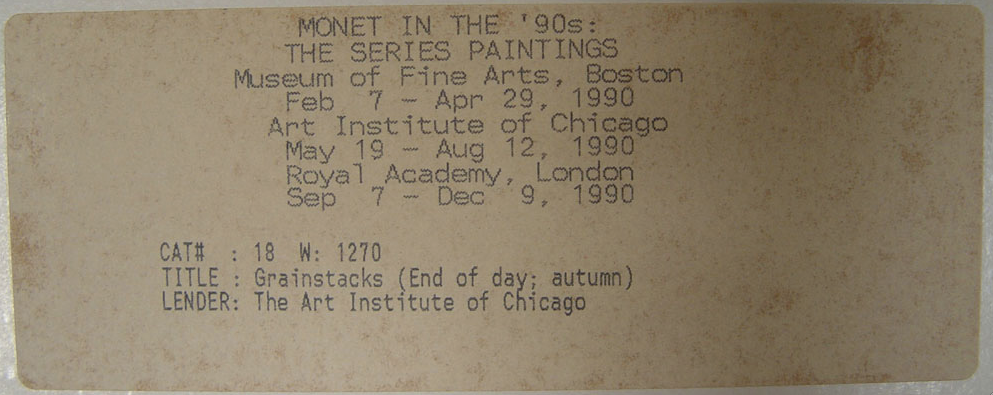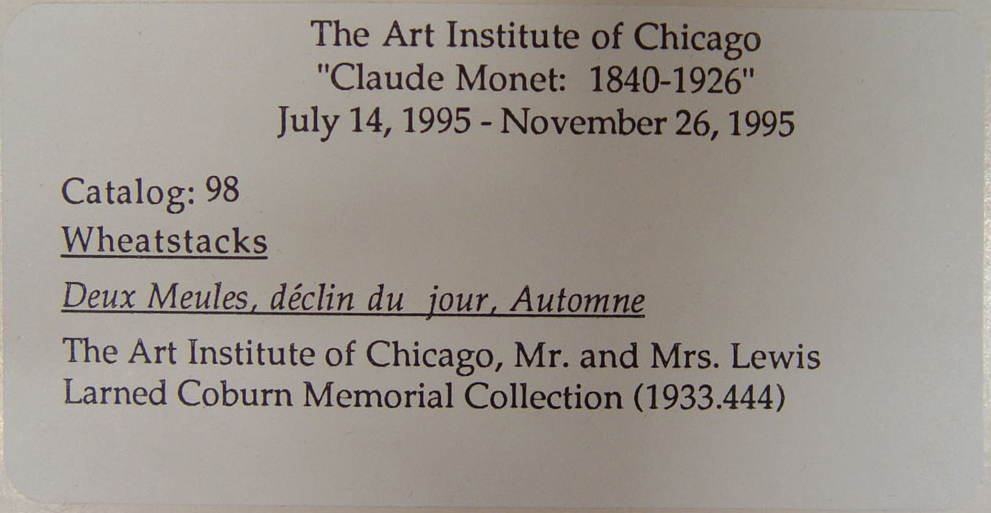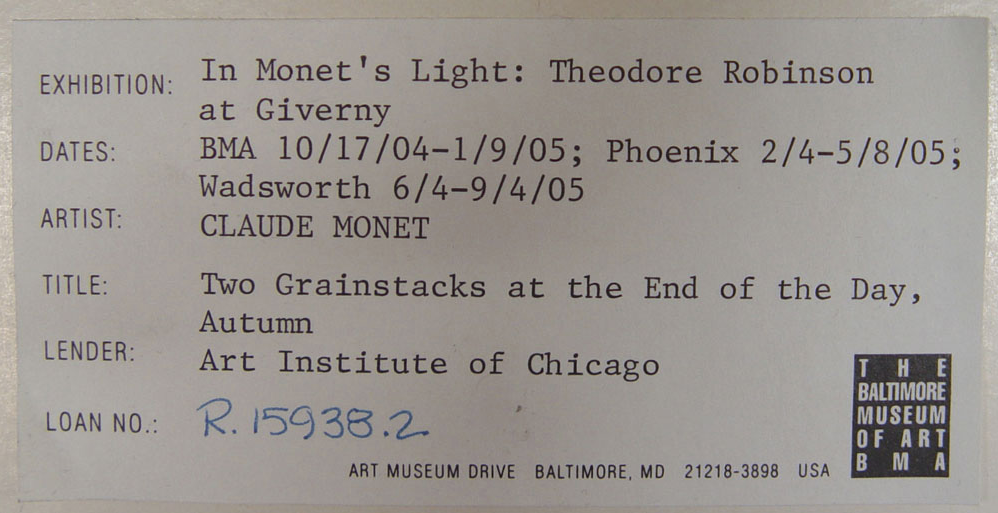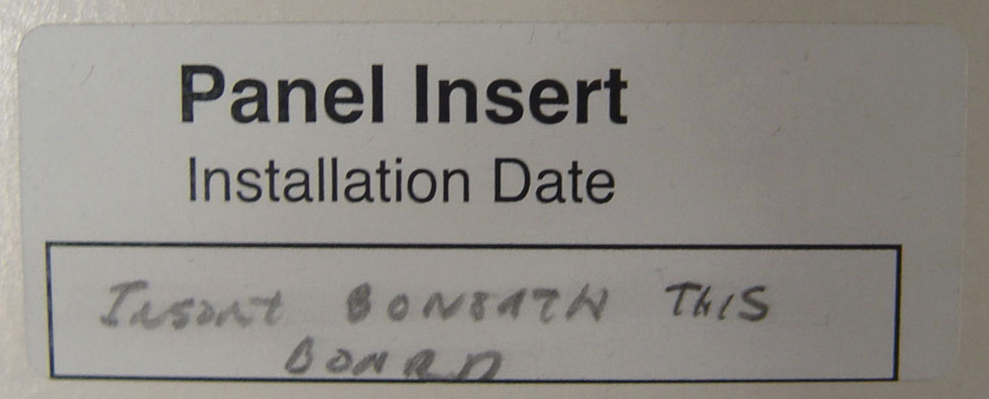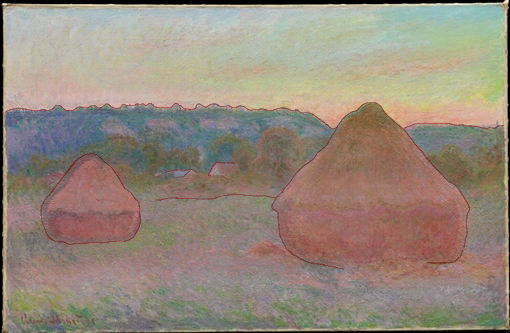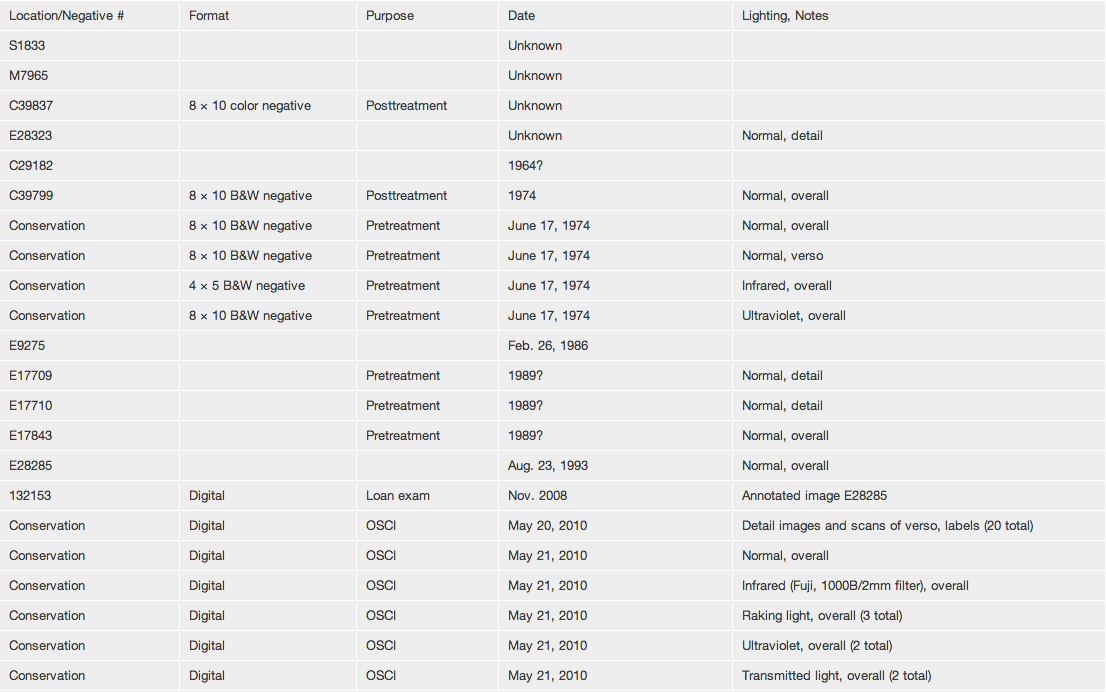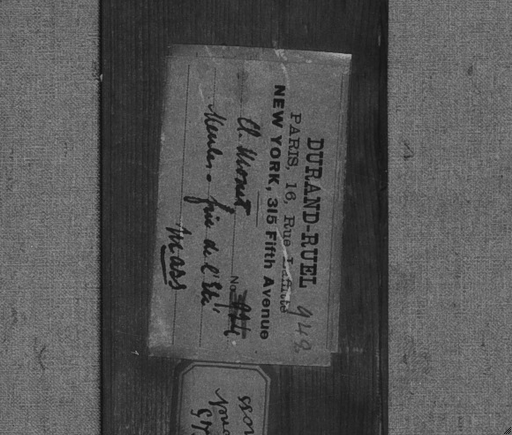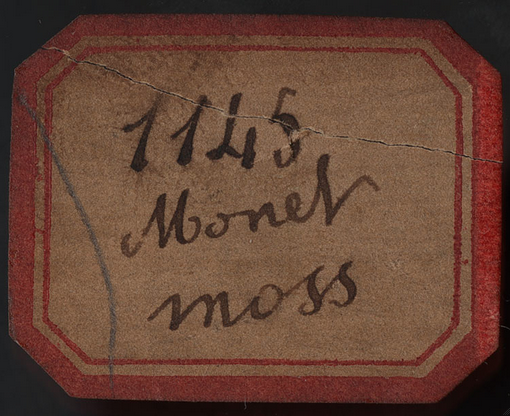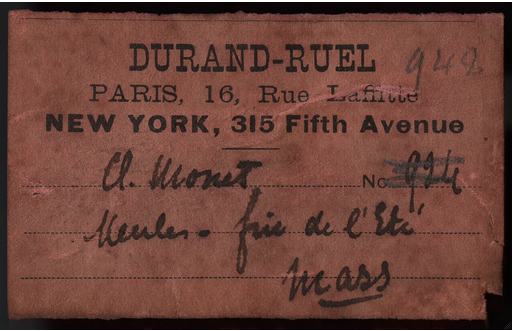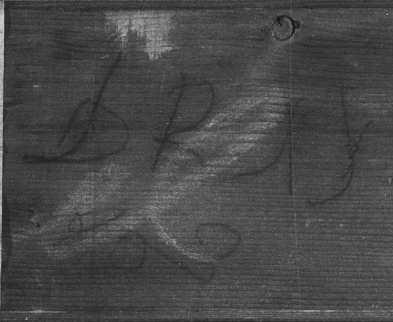Technical Report
Technical Summary
Claude Monet’s Stacks of Wheat (End of Day, Autumn) was executed on a pre-primed, no. 40 seascape (marine) standard-size linen canvas. The ground consists of a single, off-white layer. A warp-thread match was detected with seven other Monet paintings from the Art Institute’s collection: The Petite Creuse River (1889; 1922.432 [W1231]) (cat. 25), Stacks of Wheat (End of Summer) (1890/91; 1985.1103 [W1269]) (cat. 27), Stacks of Wheat (Sunset, Snow Effect) (1890/91; 1922.431 [W1278]) (cat. 29), Stack of Wheat (Thaw, Sunset) (1890/91; 1983.166 [W1284]) (cat. 32), Sandvika, Norway (1895; 1961.790 [W1397]) (cat. 34), Branch of the Seine, near Giverny (Mist) (1897; 1933.1156 [W1475]) (cat. 36), and Water Lily Pond (1900; 1933.441 [W1628]) (cat. 37), suggesting that the fabric for these paintings came from the same bolt of material. The artist built up the composition as a whole, using a relatively narrow tonal range. The main compositional areas were laid in with subdued tones and then worked up with strokes of more intense color. Technical examination of the painting revealed some alterations to the composition. The small stack at left was originally placed lower on the canvas and farther to the right. The large stack at right was originally narrower along the left side and slightly shorter compared to its size in the final painting. Probably coinciding with these changes, the two buildings in the distance and the horizon were also shifted up slightly.
Multilayer Interactive Image Viewer
The multilayer interactive image viewer is designed to facilitate the viewer’s exploration and comparison of the technical images (fig. 28.1).
Signature
Signed and dated: Claude Monet 91 (lower left, in red paint) (fig. 28.2). Claude was executed with a somewhat duller red paint, while more of the bright red paint was picked up on the brush for the second half of the signature and the date. The signature was applied when some of the underlying paint was still wet, specifically, the strokes of pale pink and bluish-purple paint, which were picked up by the signature (fig. 28.3); these strokes may represent final touches added by the artist just before signing the work.
Structure and Technique
Support
Canvas
Flax (commonly known as linen).
Standard format
The original dimensions were approximately 65 × 100 cm. This corresponds to a no. 40 seascape (marine) standard-size stretcher.
Weave
Plain weave. Average thread count (standard deviation): 23.3V (0.6) × 22.6H (0.7) threads/cm. The vertical threads were determined to correspond to the warp and the horizontal threads to the weft. A warp-thread match was determined with seven other Monet paintings: The Petite Creuse River (1889; 1922.432 [W1231]) (cat. 25), Stacks of Wheat (End of Summer)(1890/91; 1985.1103 [W1269]) (cat. 27), Stacks of Wheat (Sunset, Snow Effect) (1890/91; 1922.431 [W1278]) (cat. 29), Stack of Wheat (Thaw, Sunset)(1890/91; 1983.166 [W1284]), Sandvika, Norway (1895; 1961.790 [W1397]) (cat. 34), Branch of the Seine, near Giverny (Mist) (1897; 1933.1156 [W1475]) (cat. 36), and Water Lily Pond (1900; 1933.441 [W1628]) (cat. 37).
Canvas characteristics
Cusping is strong on the left and especially on the right edges, and milder along the top and bottom edges.
Stretching
Current stretching: Dates to the 1993 conservation treatment (see Conservation History); tacks spaced 1–5 cm apart, reusing some of the original holes. There is an additional series of small pinholes that looks more recent. This could relate to the metal strip molding applied in 1959 (see Conservation History).
Original stretching: Tack holes spaced approximately 4–7 cm apart; on the left side, there are a couple of holes quite close to the foldover. Some of the original tack holes correspond to the cusping pattern, but there are also additional tack holes in between the points of cusping. Cusping on the right edge extends beyond the cut edge of the canvas in places, indicating that the point of attachment was beyond the current canvas edge (fig. 28.4).
Stretcher/strainer
Current stretcher: Dates to the 1993 treatment (see Conservation History); five-membered wooden stretcher with vertical crossbar and keyable mortise and tenon joints (no keys present). Depth: 3 cm.
Original stretcher: Discarded. The pre-1974-treatment stretcher may have been the original stretcher. It was five-membered with a vertical crossbar, mortise and tenon joints, and ten keys (fig. 28.5). An undated report in the conservation file describes the stretcher as a “type 2” with the following dimensions: overall, 99 × 64 cm; outside depth, 2 cm; width, 7 cm; inside depth, 2 cm; distance from canvas position, 0.4 cm; length of mortise, 7 cm.
Manufacturer’s/supplier’s marks
None observed in current examination or documented in previous examinations.
Preparatory Layers
Sizing
Not determined (probably glue).
Ground Application/texture
The ground layer extends to the edges of all four tacking margins, indicating that the canvas was cut from a larger piece of primed fabric, which was probably commercially prepared. The ground consists of a single layer that ranges from approximately 20 to 100 µm in thickness (fig. 28.6).
Color
The ground is off-white with some red and black particles visible under magnification (fig. 28.7).
Materials/composition
Analysis indicates the presence of the following components: lead white and calcium carbonate (chalk), with traces of bone black, iron oxide, alumina, silica, various silicates. Binder: Oil (estimated).
Compositional Planning/Underdrawing/Painted Sketch
Extent/character
No underdrawing was observed with infrared reflectography (IRR) or microscopic examination.
Paint Layer
Application/technique and artist’s revision
The main compositional areas of the painting were laid in with subdued tones, in a rather open application that left localized areas of ground exposed. The lay-in of the sky, for example, varies slightly in color, from pale pink to pinkish-blue, but remains relatively light in tone where visible across the surface. In some areas, this underlayer appears solid and continuous while in others it exhibits open, sketchy brushwork that reveals the ground layer in places (fig. 28.8); and it does not extend all the way to the edges and corners of the painting, where the ground layer often remains visible (fig. 28.9). The hills and foliage in the distance appear to have been laid in with a light grayish-blue paint and then built up with more intense blues and greens (fig. 28.10). The paint of the small stack at left is fairly continuous, making it difficult to see the underlayers; however, the lowest layers, visible microscopically through cracks, appear to be a pale, dull green. The small stack was then built up using more intense green tones, which remain visible through breaks in the surface paint layers, which consist predominantly of red tones (fig. 28.11). The brushwork of the large stack at right is more open, revealing exposed ground and dull yellowish-green and pinkish underlayers (fig. 28.12). The field where the stacks are located appears to have been built up from a pale-toned lay-in that varies from pinkish-gray to light yellow (fig. 28.13). As observed elsewhere on the painting, the underpainting has an open, brushmarked appearance that allows the ground to show through in spots (fig. 28.14).
As the painting was built up, the artist seems to have worked across the entire canvas, moving back and forth between the different compositional elements. The painting was built up in an open network of superimposed brushstrokes that allows earlier layers to contribute to the final appearance. Cross-sectional views of the paint layers show the complex layering of the brushstrokes in areas (fig. 28.15). In the foreground, individual brushstrokes of different colors are applied over both dry and wet paint, but there is little actual wet-in-wet mixing or blending of colors (fig. 28.16). The brushwork in the sky is quite vigorous and textural, including several quickly executed, undulating zigzag strokes (fig. 28.17). The visual impact of this brushwork is somewhat subdued by the final paint application in the sky, which consists of more flatly applied paint that emphasizes the horizontal bands of color, particularly on the right side (fig. 28.18). These final applications in the sky include the orange, pink, and yellow strokes and also the more opaque blue and yellowish-green paints applied along the top and upper right edges, which seem to have been used to “finish” these sketchily painted areas where there was originally more exposed ground. The warm pinkish-orange tones of the sunset are echoed in the final touches on the surface of the foliage, grass, and stacks, imparting a warm, pinkish tonality to the landscape. Other final touches to the work include the curved strokes of orange-brown used to delineate the foliage of the trees situated at the foot of the hills in the background (fig. 28.19). These final strokes were applied with a light touch that caused them to skip over the recesses in the paint surface below, emphasizing its texture. Similar light-handed strokes were used along the horizon.
Pronounced brushstrokes unrelated to the final composition indicate that the artist made changes to both of the stacks. The small stack was originally positioned further to the right and possibly slightly lower. The large stack was expanded along the left side, making it broader and slightly taller than it was in the initial lay-in (fig. 28.20). The texture of the brushstrokes used to outline the original placement of the stacks remains visible in raking light (fig. 28.21 and fig. 28.22). In the X-ray, earlier brushstrokes used to block in the horizon line can be seen to extend underneath the left edge of the large stack until it meets up with the original edge of the stack (fig. 28.23). Similarly, under magnification, the bluish-gray paint of the initial lay-in of the hills behind can be seen through breaks in the brushwork of the stack along the edges (fig. 28.24). In building up the painting, the horizon line itself was also altered. It was moved to a higher position on the canvas, using light strokes that allow paint from the sky to show through in places (fig. 28.25). The raising of the horizon line may have coincided with the changes made to the stacks, particularly the heightening of the large stack. Where paint from the horizon and the top of the large stack extends up over the sky, the layers of the sky were dry, suggesting that some time elapsed between the original painting and the adjustments. The position of the two buildings in the middle ground was also shifted up slightly (fig. 28.26). The lower parts of these buildings (which are obscured somewhat by the reddish paint of the foliage applied on top) were laid in directly over the ground layer, whereas the roofs were painted on top of the foliage of the trees behind (fig. 28.27).
Overall, the painting has a rather rough, textural surface, owing to a buildup of brushwork that includes textural brushstrokes and low impasto, some of which are related to elements of the earlier version of the composition, as well as the texture of the canvas weave, which remains prominent. The liberal use of lightly applied strokes that skip across the highpoints of the underlying paint further accentuate the surface texture. There are many tiny bubble holes in the paint layers visible under magnification. An anomalous area of brownish-gray paint near the right edge, beginning just above the horizon, appears to be an accidental accretion, that is, wet paint coming into contact with the surface, possibly related to framing. It looks like the extraneous paint may have been lightly wiped (fig. 28.28, fig. 28.29).
Painting tools
Brushes, including 1–2 cm width, flat ferrule (based on width and shape of brushstrokes). There are several brush hairs embedded in the paint layer.
Palette
Analysis indicates the presence of the following pigments: lead white, cadmium yellow, chrome yellow, vermilion, red lake, viridian, emerald green, cobalt blue, and ultramarine blue. UV fluorescence suggests the use of red lake throughout the landscape.
Binding media
Oil (estimated).
Surface Finish
Varnish layer/media
The painting is currently unvarnished (see Conservation History). The surface has a soft, matte finish with subtle variations in gloss depending on the qualities of the paint. In 1959, the surface was described as heavily varnished and yellowed; the origin of that varnish was not documented.
Conservation History
In 1959 the back of the canvas was vacuumed, the stretcher keys were fixed, and an impregnated “CCA” fiberboard backing and metal strip molding were applied. The paint surface was superficially cleaned.
In 1971 surface grime was removed.
In 1974 a discolored surface film was removed. The canvas was wax-resin lined and restretched on an ICA spring stretcher. A layer of polyvinyl acetate (PVA) AYAA was applied. Minimal inpainting was carried out. A layer of methacrylate resin L-46 was applied, followed by a layer of AYAA.
In 1993 the AYAA and methacrylate varnish layers applied in 1974 were removed. Residues of starch paste were removed mechanically. The wax-resin lining was removed from the painting, and excess wax-resin adhesive was removed from the back of the canvas. The tacking margins were strip lined and a loose lining was attached to the stretcher. Minimal inpainting was carried out. The painting was left unvarnished.
Condition Summary
The painting is in good condition. The original canvas is strip lined and stretched taut and in plane over a loose lining with panel inserts (the 1974 wax-resin lining was removed in 1993). All of the original tacking margins are intact. The paint layer is secure. There are only a few tiny paint losses, in addition to some abrasion, pinpoint losses, and marks from the frame rebate around the edges. There are some areas of pressed or flattened paint in the rebate area, which seem to be the result of framing while the paint was still soft. Some areas of more textural paint application have a slightly flattened quality, with some moating, which probably occurred during the wax-resin-lining procedure. There are light mechanical cracks, mainly in areas of thick paint or layered applications and mostly visible only under low magnification. A fine, horizontal gouge (5.0 cm long) in the sky, near the upper left corner, occurred when the paint was still wet. There are several brush hairs embedded in the paint layer. The painting is currently unvarnished. There are scattered residues of starch paste and wax-resin adhesive from the lining process, as well as yellowed varnish residues in the recesses of the paint texture. The starch paste imparts a light scattering quality where it is concentrated.
Kimberley Muir
Frame
The current frame appears to be original to the painting. It is a French, late-nineteenth–early-twentieth-century, Louis XVI Revival, gilt, ogee frame with cast center and corner cartouches with fleur-de-lis on a diamond bed with linked foliate scrollwork and strapwork on a quadrillage bed, ending in a quirked torus and a sanded frieze with an ogee with leaf-tip molding on a recut bed at the sight edge. The construction is mitered and nailed. The back of the frame has been planed flat, removing all construction history and provenance. A back frame has been glued to the back, and all back surfaces and interior have been overpainted. The finish is oil and water gilding over red bole on cast plaster and gesso. The ornament and sight molding were selectively burnished. The torus was burnished. The toning is casein or gouache with gray overwash and whitish gray flecking. Much of the original toning has been removed, and the gilding has been rubbed heavily, altering the original balance with the painting. The molding, from perimeter to interior, is fillet with dentil motif; cove side; ogee with cast center and corner cartouches with fleur-de-lis on a diamond bed with linked foliate scrollwork and strapwork on a quadrillage bed; quirked torus; sanded frieze; and ogee with leaf tip on a re-cut ground (fig. 28.30, fig. 28.31).
Kirk Vuillemot
Provenance
Sold by the artist to Durand-Ruel, Paris, July 2, 1891, for 3,200 francs.
Sold by Durand-Ruel, New York, to Potter Palmer, Chicago, July 2, 1891, for $1,200 (or 6,000 francs).
Acquired by Durand-Ruel, New York, by Mar. 7, 1892.
Sold by Durand-Ruel, New York, to Potter Palmer, Chicago, Mar. 7, 1892, for $1,500.
Sold by Potter Palmer, Chicago, to Durand-Ruel, New York, by Apr. 19, 1892.
Sold by Durand-Ruel, New York, to Sir William Van Horne, Montreal, Apr. 19, 1892, for $1,250.
Acquired by Durand-Ruel, New York, by Nov. 22, 1892.
Sold by Durand-Ruel, New York, to Potter Palmer, Chicago, Nov. 22, 1892, for $1,200.
Acquired by Howard Young, New York, by 1932.
Acquired by Mrs. Lewis Larned (Annie Swan) Coburn, Chicago, by 1932.
Bequeathed by Mrs. Lewis Larned (Annie Swan) Coburn (died 1932), Chicago, to the Art Institute of Chicago, 1933.
Exhibition History
Art Institute of Chicago, Exhibition of the Mrs. L. L. Coburn Collection: Modern Paintings and Watercolors, Apr. 6–Oct. 9, 1932, cat. 24.
Toledo (Ohio) Museum of Art, Artists Unappreciated in Their Day, Nov. 5–Dec. 10, 1939, cat. 16 (ill.).
Seattle Art Museum, Volunteer Park, Exhibition Monet and Pissarro, Nov. 21, 1944–Jan. 24, 1945, no cat.
Englewood (Ill.) High School, Feb. 6–Mar. 6, 1945, no cat.
Art Institute of Chicago, The Paintings of Claude Monet, Apr. 1–June 15, 1957, no cat. no.
New York, Museum of Modern Art, Claude Monet: Seasons and Moments, Mar. 9–May 15, 1960, cat. 48 (ill.); Los Angeles County Museum of Art, June 14–Aug. 7, 1960.
Iowa City, University of Iowa Gallery of Art, Impressionism and Its Roots, Nov. 8–Dec. 6, 1964, cat. 35 (ill.).
Pasadena (Calif.) Art Museum (sponsored by the Art Alliance), Serial Imagery, Sept. 17–Oct. 27, 1968, cat. 1; Seattle, Henry Art Gallery, University of Washington, Nov. 17–Dec. 22, 1968; Santa Barbara (Calif.) Museum of Art, Jan. 25–Feb. 23, 1969 (Seattle only).
Art Institute of Chicago, Paintings by Monet, Mar. 15–May 11, 1975, cat. 85 (ill.). (fig. 28.32)
New York, Metropolitan Museum of Art, Monet’s Years at Giverny: Beyond Impressionism, Apr. 19–July 9, 1978, cat. 15 (ill.); Saint Louis Art Museum, Aug. 1–Oct. 8, 1978.
Los Angeles County Museum of Art, A Day in the Country: Impressionism and the French Landscape, June 28–Sept. 16, 1984, cat. 105 (ill.); Art Institute of Chicago, Oct. 23, 1984–Jan. 6, 1985; Paris, Galeries Nationales d’Exposition, Grand Palais, as L’impressionnisme et le paysage français, Feb. 4–Apr. 22, 1985.
Art Institute of Chicago, The Art of the Edge: European Frames, 1300–1900, Oct. 17–Dec. 14, 1986, not in cat.
Leningrad (now Saint Petersburg), State Hermitage Museum, Ot Delakrua do Matissa: Shedevry frantsuzskoi zhivopisi XIX–nachala XX veka, iz Muzeia Metropoliten v N’iu-Iorke i Khudozhestvennogo Instituta v Chikago [From Delacroix to Matisse: Masterpieces of French Painting of the Nineteenth to the Beginning of the Twentieth Century from the Metropolitan Museum of Art, New York, and the Art Institute of Chicago], Mar. 15–May 16, 1988, cat. 31 (ill.); Moscow, Pushkin State Museum of Fine Arts, May 30–July 30, 1988.
Boston, Museum of Fine Arts, Monet in the ’90s: The Series Paintings, Feb. 7–Apr. 29, 1990, cat. 18 (ill.); Art Institute of Chicago, May 19–Aug. 12, 1990; London, Royal Academy of Arts, Sept. 7–Dec. 9, 1990 (Boston and Chicago only).
Art Institute of Chicago, Chicago’s Dream, a World’s Treasure: The Art Institute of Chicago, 1893–1993, Nov. 1–Jan. 9, 1994, not in cat.
Art Institute of Chicago, Claude Monet, 1840–1926, July 22–Nov. 26, 1995, cat. 98 (ill.). (fig. 28.33)
Baltimore Museum of Art, In Monet’s Light: Theodore Robinson at Giverny, Oct. 17, 2004–Jan. 9, 2005, no cat. no. (ill.); Phoenix Museum of Art, Feb. 6–May 8, 2005; Hartford, Conn., Wadsworth Atheneum, June 4–Sept. 4, 2005.
Fort Worth, Tex., Kimbell Museum of Art, The Impressionists: Master Paintings from the Art Institute of Chicago, June 29–Nov. 2, 2008, cat. 76 (ill.).
Sydney, Art Gallery of New South Wales, Paths to Abstraction 1867–1917, June 26–Sept. 19, 2010, no cat. no. (ill.).
Selected References
Art Institute of Chicago, Exhibition of the Mrs. L. L. Coburn Collection: Modern Paintings and Watercolors, exh. cat. (Art Institute of Chicago, 1932), pp. 19–20, cat. 24.
Daniel Catton Rich, “The Bequest of Mrs. L. L. Coburn,” Bulletin of the Art Institute of Chicago 26, 6 (Nov. 1932), p. 66.
Toledo Museum of Art, Catalogue: Artists Unappreciated in their Day, exh. cat. (Toledo Museum of Art, 1939), pp. 2; 27, cat. 16 (ill.).
Art Institute of Chicago, “Catalogue,” Art Institute of Chicago Quarterly 51, 2 (Apr. 1, 1957), p. 33.
William C. Seitz, Claude Monet: Seasons and Moments, exh. cat. (Museum of Modern Art, New York/Los Angeles County Museum of Art/Doubleday, 1960), pp. 25 (ill.); 61, cat. 48.
Art Institute of Chicago, Paintings in the Art Institute of Chicago: A Catalogue of the Picture Collection (Art Institute of Chicago, 1961), p. 321.
John Rewald, The History of Impressionism, rev. ed. (Museum of Modern Art, New York, 1961), p. 563 (ill.).
Frank Seiberling, “A Guide to the Exhibition,” in University of Iowa Gallery of Art, Impressionism and Its Roots, exh. cat. (University of Iowa Gallery of Art, 1964), p. 7.
University of Iowa Gallery of Art, Impressionism and Its Roots, exh. cat. (University of Iowa Gallery of Art, 1964), pp. 40–41, cat. 35 (ill.).
Katharine Kuh, Break-up: The Core of Modern Art (New York Graphic Society, 1965), pp. 16–18, pl. 2; 134.
John Coplans, Serial Imagery, exh. cat. (Pasadena Art Museum, 1968), p. 139, cat. 1.
Grace Seiberling, “The Evolution of an Impressionist,” in Paintings by Monet, ed. Susan Wise, exh. cat. (Art Institute of Chicago, 1975), pp. 32, 33.
Susan Wise, ed., Paintings by Monet, exh. cat. (Art Institute of Chicago, 1975), p. 142, cat. 85 (ill.).
Metropolitan Museum of Art, Monet’s Years at Giverny: Beyond Impressionism, exh. cat. (Metropolitan Museum of Art, New York, 1978), pp. 58, cat. 15 (ill.); 156.
Daniel Wildenstein, “Monet’s Giverny,” in Metropolitan Museum of Art, Monet’s Years at Giverny: Beyond Impressionism, exh. cat. (Metropolitan Museum of Art, New York, 1978), p. 21.
Daniel Wildenstein, Claude Monet: Biographie et catalogue raisonné, vol. 3, Peintures, 1887–1898 (Bibliothèque des Arts, 1979), pp. 38; 138; 139, cat. 1270 (ill.).
Grace Seiberling, Monet’s Series (Garland, 1981), pp. 97; 357, no. 14; 421, fig. 13.
J. Patrice Marandel, The Art Institute of Chicago: Favorite Impressionist Paintings (Cross River, 1979), pp. 60–61 (ill.).
Diane Kelder, The Great Book of French Impressionism (Abbeville, 1980), pp. 183, 213 (ill.), 437.
Richard R. Brettell, “Monet’s Haystacks Reconsidered,” Art Institute of Chicago Museum Studies 11, 1 (Fall 1984), pp. 6; 12–13, pl. 4; 21, nn. 6, 7, 17, 20.
Richard R. Brettell, “The Fields of France,” in A Day in the Country: Impressionism and the French Landscape, ed. Andrea P. A. Belloli, exh. cat. (Los Angeles County Museum of Art, 1984), pp. 260; 262; 264, cat. 105 (ill.); 364.
Richard R. Brettell, “La campagne française,” in Réunion des Musées Nationaux, L’impressionnisme et le paysage français, exh. cat. (Réunion des Musées Nationaux, 1985), pp. 282–84, cat. 105 (ill.); 285–91.
John House, “Monet and the Genesis of His Series,” in Auckland City Art Gallery, Claude Monet: Painter of Light, exh. cat. (Auckland City Art Gallery/NZI, 1985), pp. 19; 20, fig. 10; 21.
John House, Monet: Nature into Art (Yale University Press, 1986), p. 27, pl. 33.
Helen Langdon, Impressionist Seasons (Phaidon, 1986), p. 56, pl. 21.
Richard R. Brettell, Post-Impressionists (Art Institute of Chicago/Abrams, 1987), pp. 35, 36 (ill.), 118.
Ministry of Culture, SSSR; State Hermitage Museum; Pushkin State Museum of Fine Arts; Metropolitan Museum of Art, New York; and Art Institute of Chicago, Ot Delakrua do Matissa: Shedevry frantsuzskoi zhivopisi XIX–nachala XX veka, iz Muzeia Metropoliten v N’iu-Iorke i Khudozhestvennogo Instituta v Chikago [From Delacroix to Matisse: Masterpieces of French Painting of the Nineteenth to the Beginning of the Twentieth Century from the Metropolitan Museum of Art, New York, and the Art Institute of Chicago], trans. from English by Iu. A. Kleiner and A. A. Zhukov, exh. cat. (Avrora, 1988), pp. 84–85, cat. 31 (ill.).
Janet M. Brooke, Discerning Tastes: Montreal Collectors, 1880–1920, exh. cat. (Montreal Museum of Fine Arts, 1989), pp. 135; 136, fig. 64; 137, n. 9; 215, no. 882.
Paul Hayes Tucker, Monet in the ’90s: The Series Paintings, exh. cat. (Museum of Fine Arts, Boston/Yale University Press, 1989), pp. 3; 77; 79, pl. 21; 296, cat. 18.
John Sallis, “Monet’s Grainstacks: Shades of Time,” Tema Celeste International Art Magazine 30 (Mar.–Apr. 1991), p. 67, n.12.
Anne Rorimer, “The Date Paintings of On Kawara,” Art Institute of Chicago Museum Studies 17, 2 (1991), p. 122, fig. 2.
Virginia Spate, Claude Monet: Life and Work (Rizzoli/Thames & Hudson, 1992), pp. 207; 209, ill. 224.
Andrew Forge, Monet, Artists in Focus (Art Institute of Chicago, 1995), pp. 44; 49; 87, pl. 16; 108.
Charles F. Stuckey, with the assistance of Sophia Shaw, Claude Monet, 1840–1926, exh. cat. (Art Institute of Chicago/Thames & Hudson, 1995), p. 119, cat. 98 (ill.)
Daniel Wildenstein, Monet, or The Triumph of Impressionism, cat. rais., vol. 1 (Taschen/Wildenstein Institute, 1996), pp. 266–67, cat. 1270 (ill.); 275.
Daniel Wildenstein, Monet: Catalogue raisonné/Werkverzeichnis, vol. 3, Nos. 969–1595 (Taschen/Wildenstein Institute, 1996), pp. 483; 485, cat. 1270 (ill.).
Karin Sagner-Düchting, “Monet’s Late Work from the Vantage Point of Modernism,” in Monet and Modernism, ed. Karin Sagner-Düchting, exh. cat. (Prestel, 2001), p. 25.
Gottfried Boehm, “‘Work’ and ‘Series’: Problems in Modern Conceptions of Pictorial Structure Since Monet,” in Monet and Modernism, ed. Karin Sagner-Düchting, exh. cat. (Prestel, 2001), pp. 154–55 (ill.).
Richard R. Brettell, From Monet to Van Gogh: A History of Impressionism, vol. 2 (Teaching Co., 2002), pp. 161, 166, 183.
Sona Johnston, In Monet’s Light: Theodore Robinson at Giverny, with an essay by Paul Tucker, exh. cat. (Baltimore Museum of Art/Philip Wilson, 2004), pp. 162, fig. 1; 163.
Norio Shimada, Inshoha bijutsukan [The history of Impressionism] (Shogakukan, 2004), p. 279 (ill.).
Barry Venning, “Turner, Monet e l’impressionismo,” in Turner e gli impressionisti: La grande storia del paesaggio moderno in Europa, ed. Marco Goldin, exh. cat. (Linea d’Ombra, 2006), p. 76 (ill.).
Norio Shimada, Claude Monet, Great Masters of Western Art 1 (Shogakukan, 2006), p. 89 (ill.).
Akiko Mabuchi, “Monet—découverte du corps et des sensations” (trans. from the Japanese by Erika Peschard-Erlih), in National Art Center, Tokyo, Monet: L’art de Monet et sa postérité, exh. cat. (National Art Center, Tokyo, 2007), pp. 29, fig. 20; 30; 246.
Eric M. Zafran, “Monet in America,” in Wildenstein and Co., Claude Monet (1840–1926): A Tribute to Daniel Wildenstein and Katia Granoff, exh. cat. (Wildenstein, 2007), p. 127.
Gloria Groom and Douglas Druick, with the assistance of Dorota Chudzicka and Jill Shaw, The Impressionists: Master Paintings from the Art Institute of Chicago, exh. cat. (Art Institute of Chicago/Kimbell Art Museum, 2008), pp. 22; 103; 108; 156; 157, cat. 76 (ill.). Simultaneously published as Gloria Groom and Douglas Druick, with the assistance of Dorota Chudzicka and Jill Shaw, The Age of Impressionism at the Art Institute of Chicago (Art Institute of Chicago/Yale University Press, 2008), pp. 22; 103; 108; 156; 157, cat. 76 (ill.).
Iris Schaefer, Caroline von Saint-George, and Katja Lewerentz, Impressionismus: Wie das Licht auf die Leinwand kam, exh. cat. (Wallraf-Richartz-Museum & Fondation Corboud/Skira, 2008), pp. 23, abb. 9; 26. Translated as Painting Light: The Hidden Techniques of the Impressionists, exh. cat. (Wallraf-Richartz-Museum & Fondation Corboud/Skira, 2008), pp. 23, ill. 9; 26.
Iris Schaefer, Caroline von Saint-George, and Katja Lewerentz, Impressionismo: Dipingere la luce, Le tecniche nascoste de Monet, Renoir e Van Gogh, ed. Monica Maroni, exh. cat. (Fondazione Palazzo Strozzi/Wallraf-Richartz-Museum & Foundation Corboud/Skira, 2008), pp. 23, ill. 9; 26.
Christie’s, London, Post-War and Contemporary Art, sale cat. (Christie’s, July 1, 2010, day auction), p. 126 (ill.).
Terence Maloon, ed., Paths to Abstraction, 1867–1917, exh. cat. (Art Gallery of New South Wales, 2010), p. 108 (ill.).
John Updike, Always Looking: Essays on Art, ed. Christopher Carduff (Knopf, 2012), pp. 74–75 (ill.).
Other Documentation
Archival Documentation from the Durand-Ruel Archives
Inventory number
Stock Durand-Ruel Paris 1063
Durand-Ruel, Paris, stock book 1891–1901, and from Brouillard 1888–1891
Inventory number
Stock Durand-Ruel New York 859
Durand-Ruel, New York, stock book 1888–1893
Inventory number
Stock Durand-Ruel New York 924
Durand-Ruel, New York, stock book 1888–1893
Inventory number
Stock Durand-Ruel New York 948
Durand-Ruel, New York, stock book 1888–1893
Other Documents
Label (fig. 28.34/(fig. 28.35)
Label (fig. 28.36)
Label (fig. 28.37)
Inscription (fig. 28.38)
Inscription (fig. 28.39)
Labels and Inscriptions
Undated
Label
Location: frame
Method: handwritten script
Content: 15 / Art Institute / of Chicago (fig. 28.40)
Number
Location: frame
Method: handwritten script
Content: 1933.444 (fig. 28.41)
Pre-1980
Label
Location: pre-1974-treatment stretcher (discarded); preserved in conservation file
Method: handwritten script
Content: 1145 / Monet / moss (fig. 28.42)
Label
Location: pre-1974-treatment stretcher (discarded); preserved in conservation file
Method: handwritten script on printed label
Content: DURAND-RUEL 948 / PARIS, 16, Rue Laffitte / NEW YORK, 315 Fifth Avenue / Cl. Monet No 924 [crossed out in pencil and 948 written at top in pencil] / Meules – fin de l’Eté / mass (fig. 28.43)
Label
Location: pre-1974-treatment stretcher (discarded); preserved in conservation file
Method: handwritten script on printed label
Content: DURAND-RUEL / PARIS, 16, Rue Laffitte / NEW YORK, 315 Fifth Avenue / Claude Monet / No 853 / Meules – fin de l’Eté / paysage de Giverny / masss (fig. 28.44)
Label
Location: pre-1974-treatment stretcher (discarded); preserved in conservation file
Method: handwritten script and stamp on printed label
Content: MAPLE & C [. . .] / 31 5, Rue Boudr[. . .] / peinture reparé [?] / champs: foins / en Meules coupé / Signé / Claude Monet
Stamp: MONS POT PALMERS (fig. 28.45, fig. 28.46)
Inscription
Location: pre-1974-treatment stretcher (discarded); 1974 photograph in conservation file
Method: handwritten script
Content: DR NY.948 (fig. 28.47)
Number
Location: pre-1974-treatment stretcher (discarded); 1974 photograph in conservation file
Method: handwritten script
Content: 30 [?] (fig. 28.48)
Inscription
Location: pre-1974-treatment stretcher (discarded); 1974 photograph in conservation file
Method: handwritten script
Content: D R N Y / [. . .] (fig. 28.49)
Inscription
Location: pre-1974-treatment stretcher (discarded); 1974 photograph in conservation file
Method: handwritten script
Content: [. . .] / Bas droite / (85[3?]) (fig. 28.50)
Number
Location: pre-1974-treatment stretcher (discarded); 1974 photograph in conservation file
Method: handwritten script
Content: 33.444 (fig. 28.51)
Post-1980
Label
Location: backing board
Method: printed label
Content: THE ART INSTITUTE OF CHICAGO / artist Claude Monet / title Haystacks, End of Day, Autumn. 1891 / medium oil on canvas / credit M/M L.L. Coburn / acct.# 1933.444 (fig. 28.52)
Label
Location: backing board
Method: printed label with typewritten script
Content: Museum of Fine Arts / Boston, MA 02115 / W. 1270 GRAINSTACK / Art I., Chicago (fig. 28.53)
Label
Location: not documented; preserved in conservation file
Method: printed label with typewritten script
Content: Museum of Fine Arts / Boston, MA 02115 / W. 1270 GRAINSTACK / Art I., Chicago (fig. 28.54)
Label
Location: frame
Method: printed label with handwritten correction
Content: SL 78.19.1[“2” written over final “1”] / MonetatGiverny / ArtInstofChicago (fig. 28.55)
Label
Location: backing board
Method: printed label
Content: MONET IN THE ’90s: / THE SERIES PAINTINGS / Museum of Fine Arts, Boston / Feb 7 – Apr 29, 1990 / Art Institute of Chicago / May 19 – Aug 12, 1990 / Royal Academy, London / Sep 7 – Dec 9, 1990 / CAT# : 18 W: 1270 / TITLE: Grainstacks (End of day; autumn) / LENDER: The Art Institute of Chicago (fig. 28.56)
Label
Location: backing board
Method: printed label
Content: The Art Institute of Chicago / “Claude Monet: 1840–1926” / July 14, 1995 – November 26, 1995 / Catalog: 98 / Wheatstacks / Deux Meules, déclin du jour, Automne / The Art Institute of Chicago, Mr. and Mrs. Lewis / Larned Coburn Memorial Collection (1933.444) (fig. 28.57)
Label
Location: backing board
Method: printed label with typewritten and handwritten script
Content: EXHIBITION: / In Monet’s Light: Theodore Robinson / at Giverny / DATES: BMA 10/17/04–1/9/05; Phoenix 2/4-5/8/05; / Wadsworth 6/4-9/4/05 / ARTIST: CLAUDE MONET / TITLE: Two Grainstacks at the End of the Day, / Autumn / LENDER: Art Institute of Chicago / LOAN NO.: R.15938.2 / ART MUSEUM DRIVE BALTIMORE, MD 21218-3898 USA / [Logo:] THE BALTIMORE MUSEUM OF ART B M A (fig. 28.58)
Number
Location: backing board
Method: handwritten script
Content: 5 (fig. 28.59)
Label
Location: backing board
Method: handwritten script on printed label
Content: Panel Insert / Installation Date / INSERT BENEATH THIS BOARD (fig. 28.60)
Label
Location: backing board
Method: handwritten script on printed label
Content: Panel Insert / Installation Date / 2-22-08 (fig. 28.61)
Label
Location: panel insert
Method: handwritten script on printed label
Content: Panel Insert / Installation Date / 2-22-08 (fig. 28.62)
Examination and Analysis Techniques
X-radiography
Westinghouse X-ray unit, scanned on Epson Expressions 10000XL flatbed scanner. Scans were digitally composited by Robert G. Erdmann, University of Arizona.
Infrared Reflectography
Fujifilm S5 Pro with X-Nite 1000B/2 mm filter (1.0–1.1 µm); Inframetrics Infracam with 1.5–1.73 µm filter.
Transmitted Infrared
Fujifilm S5 Pro with X-Nite 1000B/2 mm filter (1.0–1.1 µm).
Visible Light
Natural-light, raking-light, and transmitted-light overalls and macrophotography: Fujifilm S5 Pro with X-NiteCC1 filter.
Ultraviolet
Fujifilm S5 Pro with X-NiteCC1 filter and Kodak Wratten 2E filter.
High-Resolution Visible Light (and Ultraviolet)
Sinar P3 camera with Sinarback eVolution 75 H (B+W 486 UV/IR cut MRC filter, X-NiteCC1 filter, and Kodak Wratten 2E filter).
Microscopy and Photomicrographs
Sample and cross-sectional analysis using a Zeiss Axioplan 2 research microscope equipped with reflected light/UV fluorescence and a Zeiss AxioCam MRc5 digital camera. Types of illumination used: darkfield, differential interference contrast (DIC), and UV. In situ photomicrographs with a Wild Heerbrugg M7A StereoZoom microscope fitted with an Olympus DP71 microscope digital camera.
X-ray Fluorescence Spectroscopy (XRF)
Several spots on the painting were analyzed in situ with a Bruker/Keymaster TRACeR III-V with rhodium tube.
Polarized Light Microscopy (PLM)
Zeiss Universal research microscope.
Scanning Electron Microscopy/Energy-Dispersive X-ray Spectroscopy (SEM/EDX)
Cross sections analyzed after carbon coating with a Hitachi S-3400N-II VP-SEM with an Oxford EDS and a Hitachi solid-state BSE detector. Analysis was performed at the Northwestern University Atomic and Nanoscale Characterization Experimental Center (NUANCE), Electron Probe Instrumentation Center (EPIC) facility.
Automated Thread Counting
Thread count and weave information were determined by Thread Count Automation Project software.
Image Registration Software
Overlay images registered using a novel image-based algorithm developed by Damon M. Conover (GW), John K. Delaney (GW, NGA), and Murray H. Loew (GW) of the George Washington University’s School of Engineering and Applied Science and the National Gallery of Art, Washington, D.C.
Image Inventory
The image inventory compiles records of all known images of the artwork on file in the Conservation Department, the Imaging Department, and the Department of Medieval to Modern European Painting and Sculpture at the Art Institute of Chicago (fig. 28.63).



